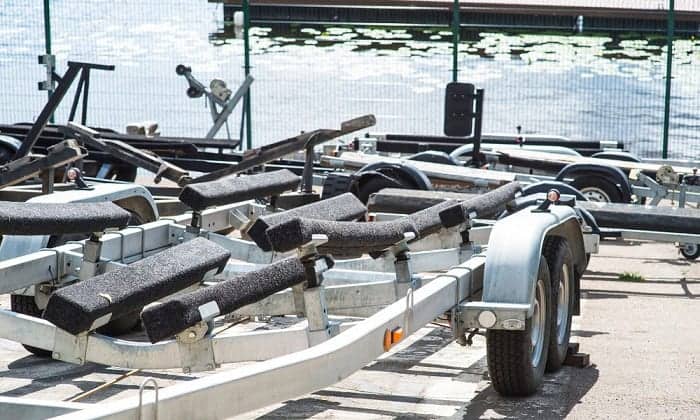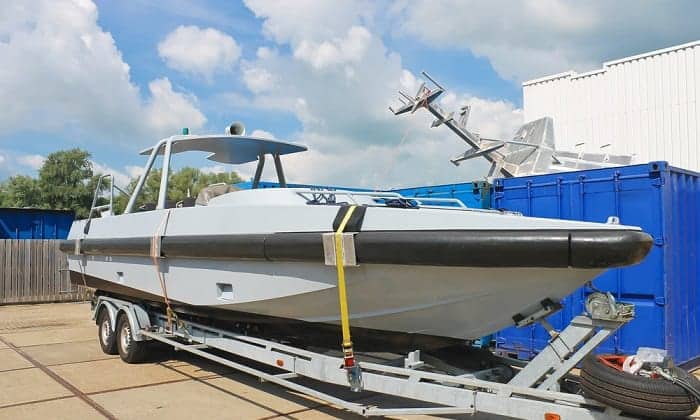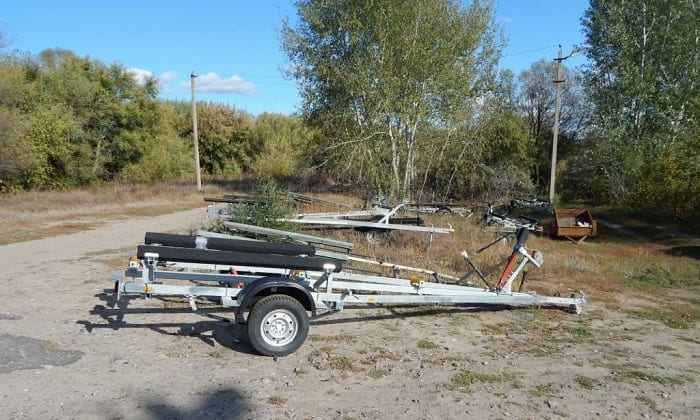Transporting your boat properly is an important aspect of boating, just as important as considerations for your boat when sailing. However, if your boat and trailer were bought separately, they may not be set up for use with each other. This can lead to damage to your boat and trailer when traveling.
In this guide, we will go over how to set up boat trailer bunks in simple steps so you can be assured that the job was done the way you want, the right way. Keep reading to learn more.
Table of Contents
What You Need
- Boat trailer bunks (2)
- Keel guides (2)
- Winch post with winch and roller
- Pair of trailer guideposts
- Wrench
- Socket wrench
- Screwdriver
- Jack
Steps To Set Up The Trailer Bunks
Step 1. Prepare your trailer
First, you need to determine if the trailer is the right one for your boat. Check to see if the keel of the boat will be able to rest on three bars on the frame of the trailer, counting from the rearmost bar. These bars will run across your boat from underneath.
You can measure this distance and compare it to the length of the boat, just remember not to include the whole length of the boat as the bow itself will not be resting on the frame itself, but the winch wheel or roller.
After determining that the trailer will fit and support the boat properly, remove any rollers on the boat. We will be using bunks exclusively for this boat trailer setup. Also, loosen the braces of your winch post if it’s already on there to give yourself room to work. However, I do recommend marking where it was placed initially.
Step 2. Prepare your bunks and braces/brackets
Before proceeding, let’s choose which bunks to use. Plastic bunks last longer and are good to use with aluminum, unlike carpet bunks, which do not work well with aluminum and the two will end up damaging each other. Carpet bunks are suitable for hulls made of fiberglass.
Some people do use some sort of rubber padding but carpet is much easier to work with when loading and unloading your boat.
Let’s assume we’re working with carpet here. Make sure that you’ve drilled the holes for the screws as well. Though if you bought your bunks carpeted and everything, it should already be fit for installation.
The bunks should be 3 to 4 inches wide, and the length should be long enough to cover the distance between the two rearmost crossbars on your trailer. As for the keel guides, 2 inches wide should do.
Step 3. Place the bunks and keel guide
Next up, place the bunks on the trailer frame with brackets. You should place them standing on the side — refer to the image below, and they should support the outer side of the hull. These will be supporting the boat the most, so we’ll use the boat trailer bunk position as a reference for the placement of the boat.
Some people prefer to place them at an angle, and while that also works, placing them on the side makes it easier to establish support without needing much guesswork on placement and measurement.
After installing the bunks in place, proceed to place the keel guides. Since they guide the keel, they should be placed at an angle supporting the keel of the bow side. You shouldn’t place the keel guides at a level that makes them support the hull, since the bunks should support most of the boat.
Step 4. Position the winch post
Now let’s get back to the winch post. Place the winch post to your desired placement. A good reference for where this placement should be is the position of the roller or wheel relative to the boat’s bow eye.
When you load the boat onto the trailer, there should be some space between the bow and the roller. When you hook the boat up to the winch, you should then be able to pull it in with the winch right up to the point where the bow is almost in contact with the roller. The roller should be right above the bow eye at this point.
When you’ve placed the winch post at the desired placement, make sure to brace it properly to the trailer. You don’t want to be careless with any installations, and the winch post is no exception.
Step 5. Install guideposts
Install the guideposts at the rear of the trailer. You can position them to have just enough space to fit the boat. You don’t need to worry about the boat needing some extra space because the keel guide will put the boat into its proper place when you drive it onto the trailer.
As the name implies, the guidepost serves to show you where you need to guide the boat as you load it onto the trailer. When you lower the trailer into the water, you won’t be able to see the trailer itself, so the guideposts will serve their purpose well and point you in the right direction.
Step 6. Place the boat on the trailer and make the necessary adjustments
After installing everything, go over to check if everything was properly installed. Make sure that braces and brackets are all fitted tightly. If everything checks out, load the boat onto the trailer for the final adjustments.
Check to see if the keel guides are placed properly. The boat should be resting on the bunks and the keel guides. You can raise the boat a bit using jacks before making the adjustments; this is to make sure that the boat will rest on the keel guides properly.
Next, check to see if the placement of the winch post is acceptable. As mentioned earlier, use the position of the winch roller relative to the bow eye. If some adjustment is necessary, you don’t need to remove the braces entirely. Just loosen the bolts on them and adjust as needed. Remember to tighten everything properly.
Pro Tips
- Choose rollers for ease of use, bunks for stability in boat transport
- Thread screws and nuts by hand even when using power tools to avoid thread issues
- Be mindful of tide conditions when loading or unloading boats with boat trailer bunks
- Use the right trailer size to protect your boat properly against impact
Conclusion
A properly set up trailer will ensure that your boat is kept in good condition and protected well while traveling. With this guide, you now know how to set up boat trailer bunks that will properly support your boat.
Hopefully, we were able to cover the important things you need to know to adjust boat trailer bunks yourself. Just remember to be thorough about the whole process and don’t rush any steps.
Was this guide useful? Please share it with other people who may need it and leave your comments as we’d love to hear from you. Remember to boat safely.

“I am James Harvey – founder of Boating Basics Online. It is established with the drive to help out first-time boaters, which are those desiring to explore their way through the water. So if you are new to boating, start from here with me. “



